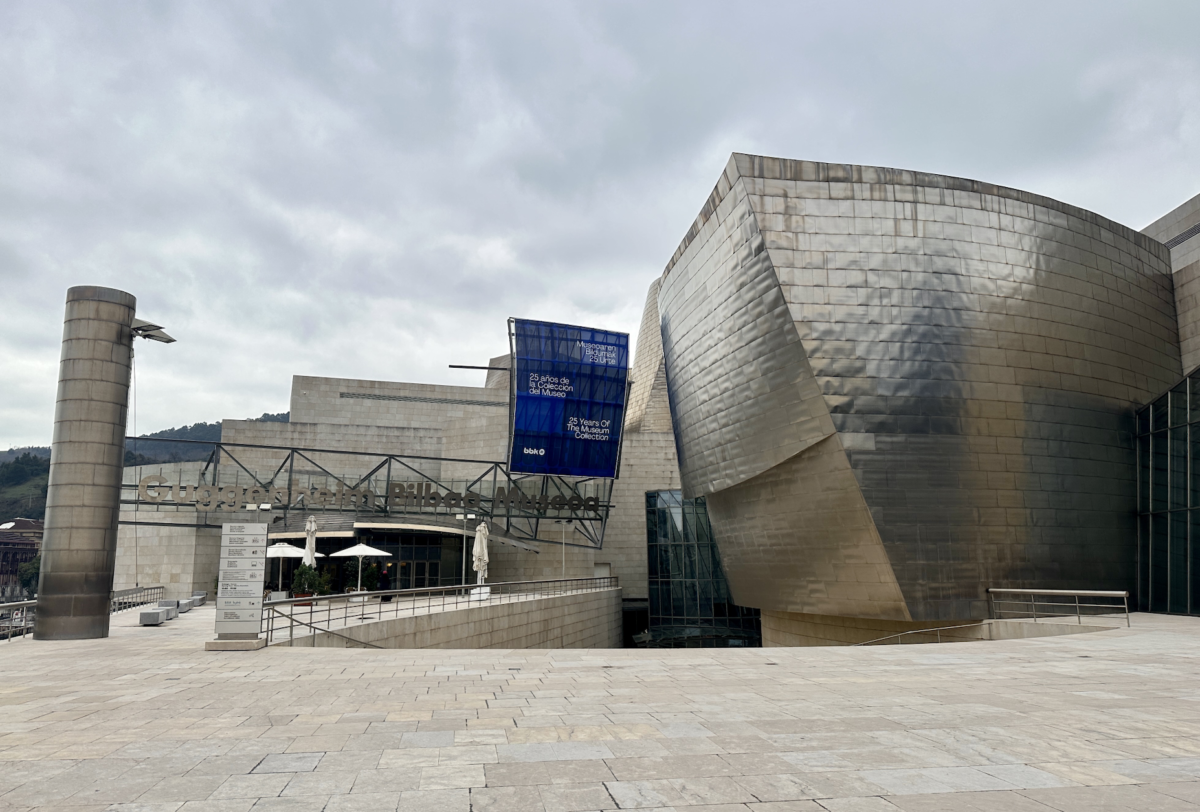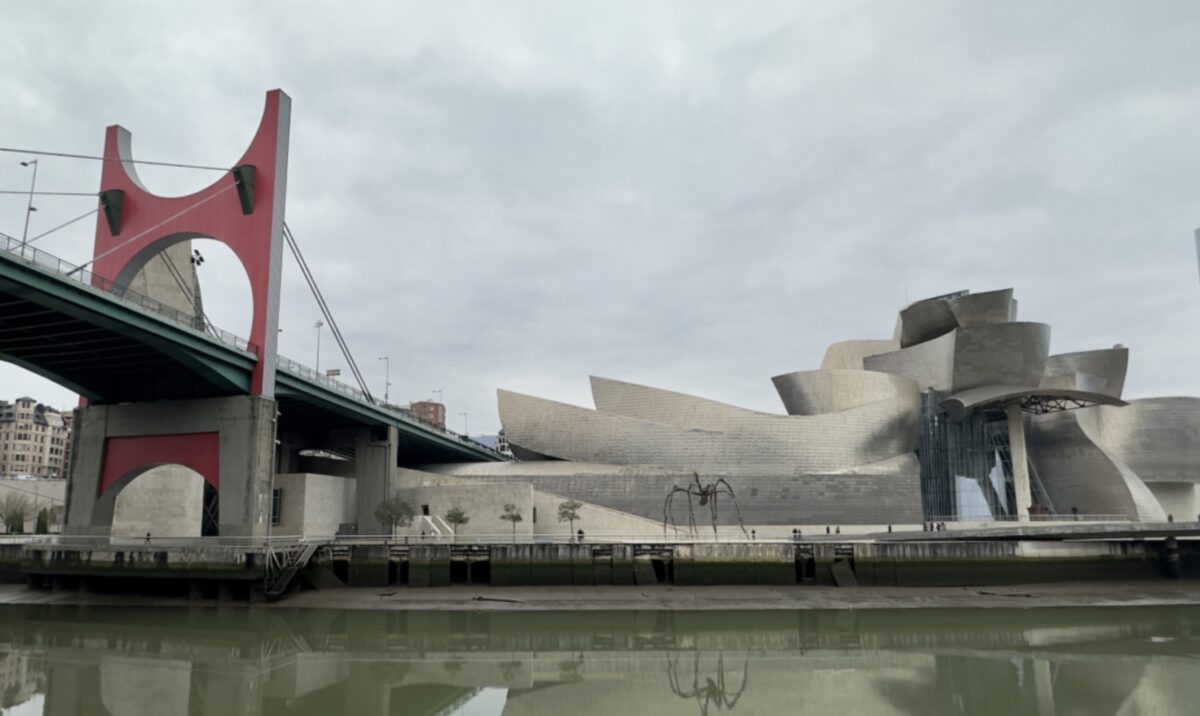— This post is part of BikePortland Staff Writer Taylor Griggs’ trip through Europe. See previous dispatches here.
Bilbao’s renewal was accompanied by a new public transit networks that spread all around the city as well as a citywide commitment to biking and walking infrastructure.
The Spanish city of Bilbao is home to about 350,000 residents, is the biggest metropolis in northern Spain’s Basque Country, and its natural beauty and unique history should be attractive to European travelers looking for something a little different. But it’s the armchair urbanists who will really find a treasure trove of riches in Bilbao.
Alright, maybe I’m just late to the game. After all, Bilbao is well-known enough amongst city planning aficionados to have an architectural concept named after it. The “Bilbao Effect” is a term coined after the 1997 construction of the Guggenheim Museum Bilbao structure: an eye-catching and critically-renowned piece of contemporary architecture that launched designer Frank Gehry into “starchitect” status à la Frank Lloyd Wright (who, of course, designed the famous Guggenheim building in New York).
While the Guggenheim Bilbao is notable for its world-class contemporary art collection, it’s the building that really sold it as an attraction worth traveling to Basque Country for. This is exactly what Bilbao politicians wanted when they appealed to the Guggenheim Foundation to build their next museum in their city, considering it their one great shot at revitalization after years of economic turmoil. And it worked, heralding substantial urban development projects like a robust Metro and tram system, beautiful parks and public spaces and more. But was there a cost?
A 2017 Guardian retrospective on the Gehry Guggenheim building includes a quote conveying the architect’s unease upon seeing his bright, extravagant building in Bilbao for the first time: “I went over the hill and saw it shining there. I thought: ‘What the fuck have I done to these people?”



I started learning about Bilbao in bits and pieces only recently, when my sister moved here to teach English for a year. I had never given much thought to visiting Basque Country, and I was very surprised to hear about how prevalent Basque culture and language is in this city.
When the Guggenheim opened in 1997, some Basque separatists violently protested. Other detractors thought of the museum as an example of American globalism, calling it “McGuggenheim.” Guggenheim naysayers feared that Bilbao’s shiny new tourist attraction and subsequent urban renewal would come at their their city’s authenticity, affordability and perhaps even the future possibility of an independent Basque Country.
From what I can tell, however, the consensus now is that the museum had a positive effect on the city, including for its Basque population. But this is only because Bilbao’s government worked hard to make sure the entire city was able to reap the Guggenheim rewards and its impact wasn’t isolated to a small, touristy area of the city where visitors would stay. If not done thoughtfully and with long-term planning, big tourist installments like this can wreak complete havoc on a city’s inhabitants — think what can happen in short-sighted cities after they host the Olympics.
Closer to home, debates about gentrification and urban renewal projects play out on a smaller scale all the time. The discourse can be hard to keep track of. (For instance: I have no idea what the temperature is on Portland’s new Ritz-Carlton, and at this point I’m too afraid to ask.) People whose worldviews are otherwise aligned can find themselves in uproarious arguments (usually on Twitter) about whether or not luxury condos or new fine dining restaurant establishments are useful to solving the affordable housing crisis or revamping Portland’s economy.
What I’ve learned from Bilbao is that a city is worth a lot more than its most “impressive” structure. It’s going to be tempting to use the existence of new luxury buildings or tourist attractions as a “gotcha” against accusations that Portland is dying, but we’re not going to get very far with that. To me, Portland’s joie de vivre is best embodied by grassroots community activities like Pedalpalooza, the Secret Roller Disco and even the fledgling local arts movement happening at the Lloyd Center.
Like I mentioned, Bilbao’s renewal was accompanied by a new public transit networks that spread all around the city as well as a citywide commitment to biking and walking infrastructure. Now, this city is topping national lists for its high pedestrian mode share (62% of all trips are taken on foot!) encouraged by the government with carfree streets in the city center and gorgeous pedestrian bridges. Bilbao isn’t necessarily known for its bike-friendliness, but I’ve been impressed by the grade-separated bike path network extending throughout its neighborhoods. If Portland’s so-called “rebirth” came with a similar move away from car infrastructure — a strategy with proven economic benefits — I think we could have a similar trajectory.
In Bilbao, beauty extends far beyond Gehry’s building. If the Guggenheim’s titanium panels — and even the Jeff Koons’ ‘Puppy’ installation on the lawn — were to suddenly disappear without a trace, the city would still be worth visiting. More importantly, it would still have resources for the people who actually call this place their home. That’s the part of the “Bilbao Effect” we need to emulate. Of course, the world-class, deconstructionist movement architecture and access to famous contemporary art is cool, too…but it’s not everything.



